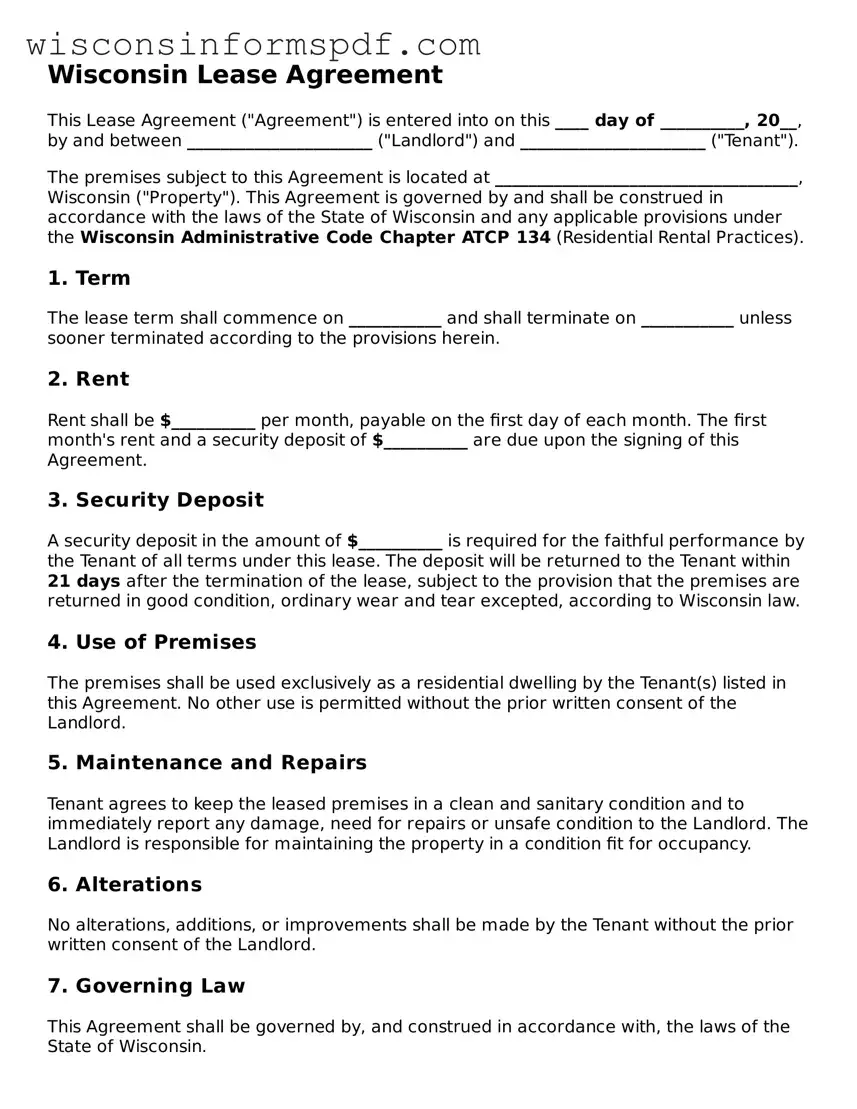The Wisconsin Lease Agreement shares similarities with the Residential Lease Agreement found in many other states. Both documents serve as a binding contract between a landlord and tenant, detailing the terms under which the tenant can occupy the property. Key similarities include provisions for rent, security deposit, term of the lease, and conditions for renewal or termination. These agreements protect both parties by outlining rights and responsibilities, ensuring a clear understanding of what is expected during the tenancy period.
Like the Wisconsin Lease Agreement, the Rental Application Form is another crucial document in the leasing process. Though not a contract, it collects personal and financial information from a prospective tenant to help the landlord assess their suitability. Both documents work hand-in-hand; the application precedes the lease agreement and influences the decision to draft the lease. Together, they facilitate a thorough vetting process, aiming to establish a trustworthy tenant-landlord relationship.
The Roommate Agreement shares common ground with the Wisconsin Lease Agreement, though it focuses specifically on the relationship between co-tenants sharing a single rental unit. While the Wisconsin Lease Agreement outlines the agreement between landlord and tenant, the Roommate Agreement delves into specifics like division of rent, utility payments, and other shared responsibilities among roommates. This document complements the main lease agreement by addressing the dynamics and expectations within the shared living space.
The Sublease Agreement aligns with the Wisconsin Lease Agreement in that it permits a tenant (sublessor) to rent out the premises they are leasing to another person (sublessee). This document mirrors the original lease in several key aspects, such as rent, security deposit, and lease term, but must also adhere to the original lease’s conditions. Both agreements ensure that the premises are used in a manner agreed upon by the original landlord, maintaining the property's condition and usage terms.
Similar to the Wisconsin Lease Agreement, the Commercial Lease Agreement covers the renting of business property but differentiates itself by catering specifically to commercial tenants. While the structure and intent—to outline the lease terms—are similar, commercial leases often include terms about commercial use, renovations, and signage, diverging from the residential focus of the Wisconsin Lease Agreement. Both set forth the expectations and responsibilities of each party during the lease term, tailored to the property type.
The Lease Renewal Agreement is directly related to the initial Wisconsin Lease Agreement, offering an extension of the leasing period under the existing or modified terms. It signifies continued agreement between the tenant and landlord beyond the original lease term, often with the option to adjust rent or other conditions. This document ensures continuity and stability for both parties, enabling a seamless extension of tenancy without the need to negotiate a completely new lease agreement.
On a different note, the Property Management Agreement parallels the Wisconsin Lease Agreement in its foundational purpose of defining a relationship, but this time between a property owner and a manager. Like the lease agreement stipulates terms between landlord and tenant, the management agreement outlines responsibilities, payment, and conditions under which a manager will operate and maintain a property on behalf of the owner. Both aim to protect the involved parties through a clear, structured arrangement.
Similar to the Wisconsin Lease Agreement is the Eviction Notice, which, although it represents a contrasting phase of the landlord-tenant relationship, is rooted in the terms initially laid out in the lease. This document serves as a formal notification from the landlord to the tenant, detailing breaches of the lease agreement and providing a resolution period or announcing the termination of tenancy. It enforces the lease’s conditions by clearly stating the consequences of violating its terms.
The Condition of Rental Property Checklist complements the Wisconsin Lease Agreement by documenting the state of the rental property at the time of move-in and move-out. This tool is crucial for both tenants and landlords to ensure that the premises are returned in a condition comparable to the start of the lease, barring normal wear and tear. Used together, these documents help avoid disputes over security deposits and property damage, ensuring both parties are treated fairly.
Last but not least, the Landlord’s Notice to Enter is akin to the Wisconsin Lease Agreement in that it respects and reinforces the rights and responsibilities defined in the lease. This notice provides the tenant with a heads-up when the landlord needs access to the property, typically for maintenance or inspection. While it stands as an independent document, it underscores the landlord's right to enter the premises under conditions agreed upon in the lease, maintaining the balance of rights between tenant and landlord.
